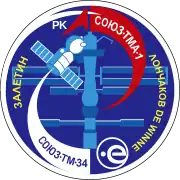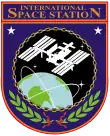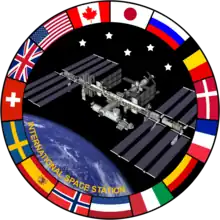 TMA-1 approaches the ISS | |
| Mission type | ISS crew transport |
|---|---|
| Operator | Rosaviakosmos |
| COSPAR ID | 2002-050A |
| SATCAT no. | 27552 |
| Mission duration | 185 days, 22 hours, 53 minutes, 14 seconds |
| Orbits completed | ~3,020 |
| Spacecraft properties | |
| Spacecraft | Soyuz 11F732 No.211[1] |
| Spacecraft type | Soyuz-TMA 11F732 |
| Manufacturer | RKK Energia |
| Crew | |
| Crew size | 3 |
| Launching | Sergei Zalyotin Frank De Winne Yury Lonchakov |
| Landing | Nikolai Budarin Kenneth Bowersox Donald Pettit |
| Callsign | Yenisey |
| Start of mission | |
| Launch date | October 30, 2002, 03:11:11 UTC |
| Rocket | Soyuz-FG |
| Launch site | Baikonur 1/5 |
| End of mission | |
| Landing date | May 4, 2003, 02:04:25 UTC |
| Landing site | 49.39° N; 61.2° E |
| Orbital parameters | |
| Reference system | Geocentric |
| Regime | Low Earth |
| Perigee altitude | 383 kilometres (238 mi) |
| Apogee altitude | 402 kilometres (250 mi) |
| Inclination | 51.6 degrees |
| Period | 92.4 minutes |
| Epoch | 6 November 2002[2] |
| Docking with ISS | |
| Docking port | Pirs nadir |
| Docking date | 1 November 2002 05:01 UTC |
| Undocking date | 3 May 2003 22:43 UTC |
| Time docked | 183d 17h 42m |

 From left to right: Frank de Winne, Sergei Zalyotin and Yuri Lonchakov Soyuz programme (Crewed missions) | |
Soyuz TMA-1[lower-alpha 1], also catalogued as Soyuz TM-35, was a 2002 Soyuz mission to the International Space Station (ISS) launched by a Soyuz FG launch vehicle with a Russian-Belgian cosmonaut crew blasted off from the Baikonur Cosmodrome in Kazakhstan.[3] This was the fifth Russian Soyuz spacecraft to fly to the ISS. It was also the first flight of the TMA-class Soyuz spacecraft.[4] Soyuz TM-34 was the last of the prior Soyuz-TM spacecraft to be launched.
Crew
| Position | Launching crew | Landing crew |
|---|---|---|
| Commander | Second and last spaceflight |
Expedition 6 Soyuz Commander Third and last spaceflight |
| Flight Engineer | First spaceflight |
Expedition 6 ISS Commander/Soyuz Flight Engineer Fifth and last spaceflight |
| Flight Engineer | Second spaceflight |
Expedition 6 Flight Engineer First spaceflight |
Mission parameters
- Mass: 7,220 kg (15,910 lb), gross
- Perigee: 193 km
- Apogee: 235 km
- Inclination: 51.6°
- Period: 88.7 minutes
Docking with ISS
Specifications
- Section ref: Astro[5]
- Gross mass: 7,220 kg (15,910 lb).
- Unfuelled mass: 6,320 kg (13,930 lb).
- Height: 6.98 m (22.90 ft).
- Diameter: 2.20 m (7.20 ft).
- Span: 10.70 m (35.10 ft).
- Thrust: 3.92 kN (881 lbf).
- Specific impulse: 305 s.
Mission highlights
In the spring of 2001, a taxi mission to the space station was being scheduled to take place in October 2002. At first the crew was to be Commander Sergei Zalyotin and Flight Engineer Frank De Winne; however, a report released in February 2002 stated that American musician Lance Bass was interested in joining the crew for a one-week mission on board the Russian spacecraft. The mission began to fall through, and by September 2002 they had discontinued the training of Lance Bass due to the mission organizers' failure to meet the terms of the contract. They filled the vacant seat left by Lance Bass with Russian cosmonaut Yuri Lonchakov.
While the Soyuz TMA-1 was on orbit, the Columbia shuttle accident occurred and required a change in crew changeout process. The Soyuz system would become the sole method for crew to launch to and return from ISS, until the space shuttle was returned to service in July 2005.
Soyuz TMA-1 disembarked from ISS on May 4, 2003 and immediately began its return to Earth, marking the first entry and descent for this Soyuz class. A technical malfunction caused the Soyuz control system to abandon the gentler controlled entry and descent and instead fall back to the harsher ballistic reentry and descent. This resulted in a steep and off target landing of the spacecraft. The craft landed 300 miles short of the planned area, and the crew was subjected to severe acceleration loads. Communication with the Soyuz was lost because one antenna was ripped off during descent, and two more did not deploy. The crew regained communications through an emergency transmitter after landing. Due to this event, future crews would be provided with a satellite phone to establish contact with recovery forces.
Subsequent Soyuz TMA missions were able to successfully execute controlled reentries, until the Soyuz TMA-10 and Soyuz TMA-11 missions which both also reverted to ballistic descents.
References
- ↑ McDowell, Jonathan. "Launch Log". Jonathan's Space Page. Retrieved 9 November 2013.
- ↑ McDowell, Jonathan. "Satellite Catalog". Jonathan's Space Page. Retrieved 9 November 2013.
- ↑ Quest.NASA.gov Space report No.46 Archived 2008-09-17 at the Wayback Machine
- ↑ RussianSpaceWeb.com: Soyuz TMA-1
- ↑ Astronautix.com: Soyuz TMA Archived 2009-04-14 at the Wayback Machine
Footnotes
- ↑ T – транспортный – Transportnyi – meaning transport,
M – модифицированный – Modifitsirovannyi – meaning modified,
A – антропометрический, – Antropometricheskii meaning anthropometric).


